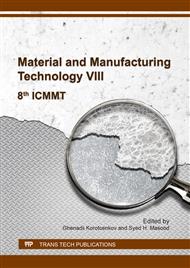p.238
p.245
p.252
p.257
p.267
p.272
p.278
p.283
p.287
Properties of GGBFS-Based Pervious Concrete Containing Fly Ash and Silica Fume
Abstract:
Pervious concrete primarily is used as a means of storm water management. Taking into consideration the environment issues, the binder can also be formed by partially replaced Portland cement by cementitious materials, such as blast furnace slag fine powder, fly ash and silica fume. The combination of the binder materials was determined based on previous work, which composed of 56% Portland Composite Cement, 15% fly ash Type F, 26% air-cooled blast furnace slag from a local steel Industry and 3% condensed silica fume. The compressive strength of specimens with coarser aggregate was lower compared with the control pervious concrete, but still within the range of the requirement compressive strength according to ACI 522R-2010. The difference of the aggregate size affected the enhancement of the compressive strength. The flexural strength of pervious concrete with aggregate size of 9.5mm-12.5mm tend to be higher compared with that of pervious concrete with smaller aggregate size. Furthermore, the addition of 6% natural fine aggregate while applying higher water/cement ratio could be a contribution to the enhancement of the compressive and the flexural strength.
Info:
Periodical:
Pages:
278-282
Citation:
Online since:
October 2017
Authors:
Keywords:
Price:
Сopyright:
© 2017 Trans Tech Publications Ltd. All Rights Reserved
Share:
Citation:


